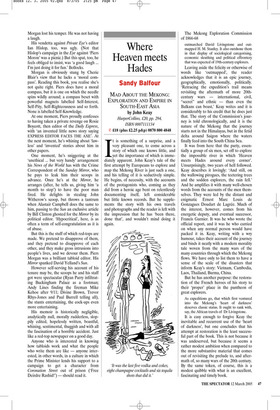Where Heaven meets Hades
Sandy Balfour
MAD ABOUT THE MEKONG: EXPLORATION AND EMPIRE IN SOUTH-EAST ASIA by John Keay HarperCollins, £20, pp. 294, ISBN 0007111134 ✆ £18 (plus £2.25 p&p) 0870 800 4848 It is something of a surprise, and a very pleasant one, to come across a story of which one knows little, and yet the importance of which is immediately apparent. John Keay’s tale of the first attempt by Europeans to explore and map the Mekong River is just such a one, and his telling of it is seductively simple. He begins, of necessity, with the accounts of the protagonists who, coming as they did from a heroic age bent on relentlessly documenting itself, left considerable but little known records. But he supplements the story with his own travels and photographs and the reader is left with the impression that he has ‘been there, done that’, and wouldn’t mind doing it again. The Mekong Exploration Commission of 1866-68
outmarched David Livingstone and out mapped H. M. Stanley. It also outshone them in that display of sociological categorising, economic sleuthing and political effrontery that was expected of 19th-century explorers.
Leaving aside the felicity or otherwise of words like ‘outmapped’, the reader acknowledges that it is an epic journey, geographically, emotionally, politically. ‘Retracing the expedition’s trail means revisiting the aftermath of more 20thcentury wars — international, civil, “secret” and ethnic — than even the Balkans can boast,’ Keay writes and it is considerably to his credit that he does just that. The story of the Commission’s journey is told chronologically, and it is the nature of the Mekong that the journey starts not in the Himalayas, but in the fetid delta around Saigon where the waters finally feed into the South China Sea.
It was from here that the party, essentially a group of six men, set off to explore the impossible river in which ‘Heaven meets Hades around every corner’. Unsurprisingly, two years of hell followed. Keay describes it lovingly: ‘And still, on the wallowing pirogues, the teetering trees and the sodden explorers, the rain fell.’ And he amplifies it with many well-chosen words from the accounts of the men themselves. They were led by the distant and enigmatic Ernest Marc Louis de Gonzagues Doudart de Lagrée. Much of the interest, however, comes from his energetic deputy, and eventual successor, Francis Garnier. It was he who wrote the official report, and it was he who carried on when any normal person would have packed it in. Keay, writing with a wry humour, takes their account of the journey and binds it neatly with a modern morality tale woven from the many wars of the many countries through which the Mekong flows. We have only to list them to have a sense of the scale of the disasters that inform Keay’s story: Vietnam, Cambodia, Laos, Thailand, Burma, China.
But he has another purpose: the restoration of the French heroes of his story to their ‘proper’ place in the pantheon of great explorers.
As expeditions go, that which first ventured into the Mekong’s ‘heart of darkness’ deserves classic status. It ought to rank with, say, the African travels of Dr Livingstone.
It is easy enough to forgive Keay the inevitable and recurrent use of the ‘heart of darkness’, but one concludes that his attempt at restoration is the least successful part of the book. This is not because it was undeserved, but because it seems a rather modest ambition when compared to the more substantive material that comes out of revisiting the prelude to, and aftermath of, so many wars of the 20th century. By the same token, of course, this is a modest quibble with what is an excellent, fascinating and timely book.
































































 Previous page
Previous page